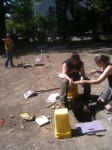Week two at Newton was spent excavating ten shovel test pits along the south (right) and west (front) facades of the house. Shovel test pits (STPs) are 50 x 50 centimeter square holes oriented on a grid system that give us an idea of the kinds of activities that occurred during the life history of the site. We collect artifacts from different soil layers that vary according to color, texture, and composition. Artifacts, combined with irregularities in the stratigraphy, help us pinpoint date ranges for house-related activities and give us an idea of what to look for in other areas of the site.
Along the side of the house, STPs revealed an area of built up rubble next to the foundation containing mostly large cobbles and brick. Two STPs had a buried ground surface about 35 centimeters (1 foot) below the current ground level. An STP at the southwest corner of the house uncovered a decorated rim sherd from a white salt-glazed stoneware plate. This ceramic type, as well as the distinctive “Dot, Diaper, and Basketweave” decoration, was popular during the mid-eighteenth century, giving us a clearly defined date range for the deposit in which it was found. Along the driveway, STP 5 unearthed a cobbled surface that may be a part of an older paved surface. Several STPs along the front of the house had a layer of dense stone rubble, most likely deposited during the construction of the foundation. Some notable artifacts found included creamware, hand painted pearlware, Westerwald stoneware, Staffordshire slipware, Imari style Porcelain, pipe stems, and several buttons. This week we’ve done some STPs and larger units behind the house, more information on those coming soon!
–Danielle and Samantha

